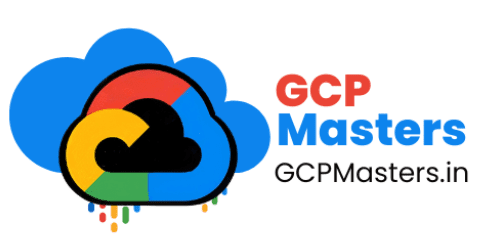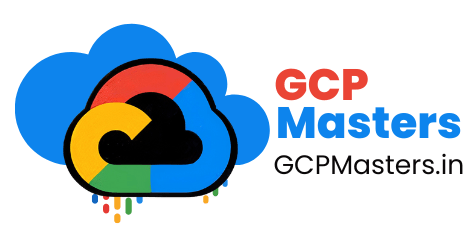Google Cloud Platform for IoT
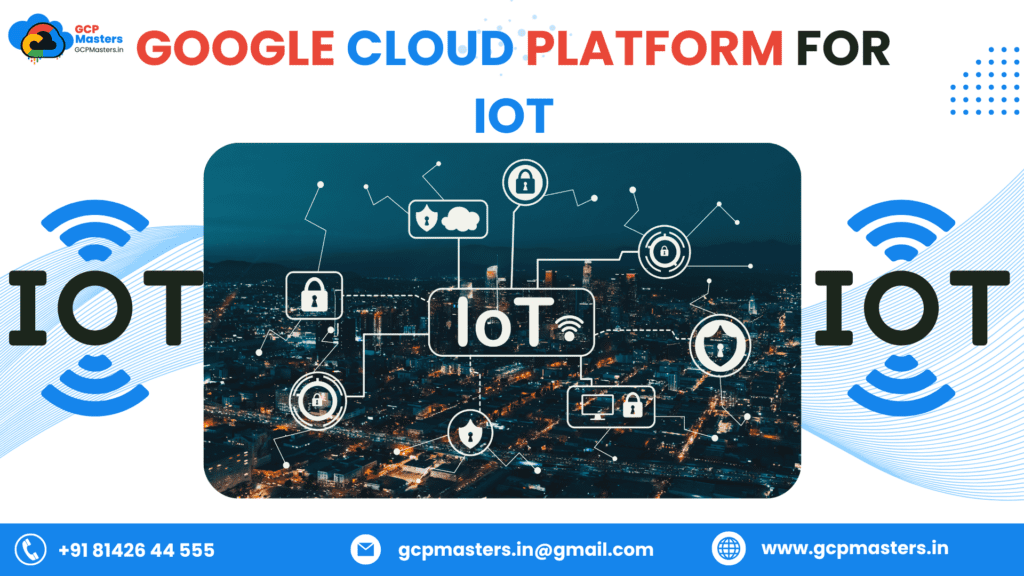
Overview Google Cloud Platform for IoT
The Internet of Things (IoT) is transforming the way devices interact, communicate, and share data over the internet. From smart homes and connected vehicles to industrial automation and healthcare monitoring, IoT is driving innovation across industries. With billions of devices generating vast amounts of data, efficient data processing, storage, and security are crucial for seamless operations.
Importance of Google Cloud Platform for IoT Solutions
IoT devices generate huge volumes of data that need real-time processing, secure storage, and seamless accessibility. Cloud computing plays a vital role in IoT by offering:
- Scalability – Ability to manage millions of devices and data streams
- Data Storage & Analytics – Secure and scalable storage with advanced data processing capabilities
- Real-time Insights – AI and machine learning-powered analytics for predictive maintenance and automation
- Security – End-to-end encryption, authentication, and threat detection for connected devices

Why Google Cloud Platform for IoT is a Powerful Choice
Google Cloud Platform provides a comprehensive suite of services tailored for IoT applications. GCP’s serverless, AI-powered, and highly scalable ecosystem makes it an ideal choice for managing IoT workloads. Key benefits of using GCP for IoT include
- Cloud IoT Core – Secure device management and data ingestion
- Real-time Data Processing – Services like Pub/Sub, Dataflow, and BigQuery help process and analyze IoT data efficiently
- AI & Machine Learning – Vertex AI enables smart automation and predictive insights
- Security & Compliance – Advanced security features, including IAM, encryption, and threat detection
- Seamless Integration – GCP integrates easily with third-party IoT platforms and edge computing solutions
Key Challenges in IoT and How Google Cloud Platform for IoT Helps
The Internet of Things (IoT) connects various devices, allowing them to communicate and share data. However, managing large-scale IoT systems comes with several challenges.
Managing a Large Number of Devices
Challenge:
- Connecting and handling millions of devices at the same time
- Ensuring smooth and fast communication between devices
- Keeping track of device updates and monitoring their status
Solution:
- Cloud platforms provide tools to manage and connect devices efficiently
- Edge computing helps process data closer to the devices, reducing delays
- Load balancing ensures the system works smoothly even with high traffic
Ensuring Data Security and Privacy
Challenge:
- Protecting data from hackers and cyber threats
- Keeping device communications safe from unauthorized access
- Controlling who can access and manage IoT data
Solution:
- Cloud platforms offer security tools like encryption and identity management
- Data is protected both while being sent and when stored in the cloud
- Threat detection systems help identify and prevent security risks
Processing and Analyzing Data in Real Time
Challenge:
- Handling large amounts of data generated by IoT devices
- Extracting useful insights from raw data
- Storing and analyzing data efficiently
Solution:
- Cloud services process data in real time, making quick decisions possible
- Big data tools help analyze and store large volumes of information
- Artificial intelligence and machine learning provide predictive insights
Making Different Devices Work Together
Challenge:
- Devices use different communication protocols, making integration difficult
- Some IoT systems use outdated technology that may not work with new devices
- Managing multiple devices from different manufacturers
Solution:
- Cloud platforms support various communication methods to connect devices
- APIs and software tools help devices interact smoothly
- Third-party integrations allow compatibility between different IoT systems
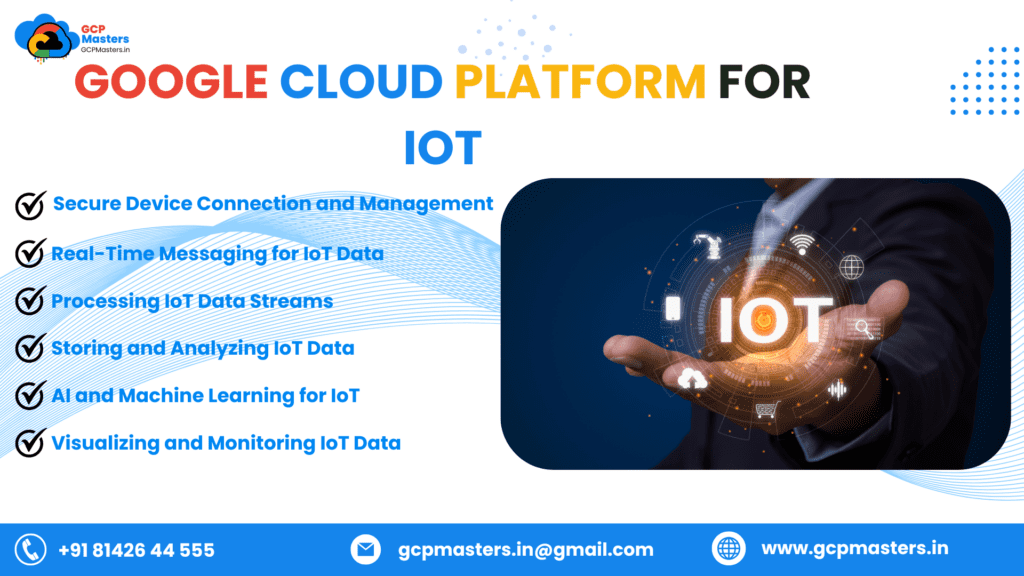
Google Cloud Platform Services for IoT
Google Cloud Platform provides various services to help businesses manage IoT devices, process large amounts of data, and gain insights using artificial intelligence and analytics. These services work together to ensure smooth operation, security, and efficiency in IoT systems.
Secure Device Connection and Management
For an IoT system to function properly, devices must be securely connected to the cloud and managed efficiently. Google Cloud provides tools to register devices, monitor their activity, and ensure they communicate securely.
- Helps businesses connect thousands or even millions of devices without issues
- Ensures safe and encrypted communication between devices and cloud applications
- Supports different connection methods to make it easier for various devices to work together
Real-Time Messaging for IoT Data
IoT devices constantly send and receive data. This data needs to be processed and delivered instantly to be useful. Google Cloud Platform provides services that allow messages to flow smoothly between devices and cloud systems.
- Makes sure messages from devices are delivered quickly and without delays
- Helps manage large volumes of data sent by sensors and smart devices
- Ensures that information reaches the right applications for further processing
Processing IoT Data Streams
Many IoT devices, such as sensors in factories or smart home systems, generate continuous streams of data. Google Cloud Platform provides tools that help process this information as it arrives, ensuring that important data is quickly identified and used.
- Processes data instantly, allowing businesses to respond in real time
- Helps clean, organize, and filter raw sensor data for further analysis
- Supports both continuous real-time processing and batch processing when needed
Storing and Analyzing IoT Data
Since IoT systems generate vast amounts of information, businesses need a secure and scalable way to store and analyze it. Google Cloud Platform offers solutions to store large datasets and retrieve meaningful insights efficiently.
- Stores IoT data safely while making it easily accessible for analysis
- Allows businesses to search and analyze data quickly to find useful patterns
- Integrates with machine learning tools to predict future trends and improve operations
AI and Machine Learning for IoT
Artificial intelligence (AI) and machine learning (ML) can help businesses make better use of IoT data by detecting patterns, predicting problems, and automating decisions. Google Cloud offers AI-powered solutions to make IoT systems smarter.
- Helps businesses predict issues before they occur, such as machine failures
- Identifies trends in IoT data to improve efficiency and reduce costs
- Automates decision-making processes to respond to real-time events
Visualizing and Monitoring IoT Data
To fully understand IoT data, businesses need tools to track performance, identify trends, and monitor operations in real time. Google Cloud provides dashboard and reporting tools that help businesses visualize IoT data easily.
- Creates interactive dashboards to monitor device activity and system performance
- Helps businesses track trends and identify unusual behavior in IoT networks
- Generates reports that assist in making informed decisions

oT Architecture on Google Cloud Platform for IoT
Building an IoT system on Google Cloud involves multiple layers, each designed to handle different aspects of device management, data processing, security, and intelligent insights.
Device Connectivity
IoT devices need a reliable way to connect to the cloud, send data, and receive commands. Google Cloud provides services to manage millions of devices efficiently.
- IoT Core helps register, authenticate, and manage connected devices
- Supports communication using MQTT and HTTP protocols
- Ensures secure data exchange between devices and cloud applications
Data Ingestion and Processing
Once data is collected from IoT devices, it needs to be processed and analyzed in real time or stored for later use. Google Cloud provides services to handle data efficiently.
- Cloud Pub/Sub ensures reliable data ingestion by managing messages from devices
- Cloud Dataflow processes data streams in real time, filtering and transforming it
- BigQuery helps store and analyze large datasets, making it easier to find insights
Security Measures
Security is a crucial aspect of IoT, as devices generate sensitive data that must be protected from unauthorized access and cyber threats.
- Authentication ensures that only authorized devices can connect to the cloud
- Encryption protects data while being transmitted and when stored
- Threat protection tools detect and respond to security risks in real time
Integration with AI and Machine Learning
IoT data can provide valuable insights when combined with artificial intelligence and machine learning. Google Cloud offers AI-powered tools to enhance IoT solutions.
- Vertex AI analyzes IoT data and provides predictive insights
- Helps detect anomalies and failures in devices before they happen
- Improves automation and decision-making based on real-time data patterns
Real-World IoT Use Cases on Google Cloud Platform for IoT
The Internet of Things (IoT) is transforming industries by connecting devices, collecting data, and enabling smarter decision-making. Google Cloud provides powerful tools to help businesses and organizations use IoT effectively. Here are some practical ways IoT is being used with Google Cloud
Smart Cities – Traffic Management and Pollution Monitoring
Many cities are using IoT to improve transportation systems, reduce pollution, and enhance public services.
- Traffic Management: Sensors placed at intersections and roads collect data on traffic flow. This data is sent to Google Cloud, where AI analyzes patterns and optimizes traffic lights to reduce congestion.
- Pollution Monitoring: Air quality sensors measure pollution levels in different areas. City officials use this data to issue warnings, adjust traffic patterns, or take action to reduce emissions.
- Smart Lighting: Streetlights equipped with sensors adjust brightness based on real-time conditions, reducing energy waste and saving costs.
Industrial IoT (IIoT) – Predictive Maintenance in Factories
Factories use IoT to monitor machines, detect problems early, and prevent costly breakdowns.
- Machine Health Monitoring: Sensors on machines track temperature, vibrations, and performance. If an issue is detected, the system sends alerts before a breakdown occurs.
- Predictive Maintenance: AI analyzes machine data to predict failures, helping factories schedule repairs in advance and reduce downtime.
- Automation: Robots and smart machines use IoT to coordinate production lines, improving efficiency and reducing human errors.
Healthcare IoT – Wearables and Remote Patient Monitoring
IoT is playing a big role in healthcare by helping doctors monitor patients remotely and improving personalized care.
- Wearable Devices: Smartwatches and fitness trackers measure heart rate, oxygen levels, and activity. Doctors can monitor this data to detect health issues early.
- Remote Patient Monitoring: Hospitals use IoT devices to track a patient’s condition without requiring them to stay in the hospital. This reduces hospital visits and improves patient comfort.
- AI-Based Diagnostics: AI analyzes IoT health data to identify risks like irregular heartbeats, high blood sugar, or breathing problems, allowing early medical intervention.
Smart Agriculture – Automated Irrigation and Crop Monitoring
Farmers use IoT to monitor crops, automate irrigation, and improve yields.
- Soil and Weather Monitoring: Sensors in the soil measure moisture levels, temperature, and nutrients. Based on this data, automated irrigation systems water crops only when needed, reducing water waste.
- Crop Health Monitoring: Drones and smart cameras capture images of fields. AI analyzes these images to detect plant diseases, pests, or nutrient deficiencies.
- Smart Farming Decisions: Data collected from sensors helps farmers decide the best time to plant, water, and harvest crops, leading to better productivity and reduced costs.
Connected Vehicles – Fleet Management and Real-Time Tracking
Businesses and transportation companies use IoT to track vehicles, monitor performance, and improve safety.
- Real-Time Tracking: GPS-enabled IoT devices installed in vehicles send location data to the cloud, allowing businesses to track fleets in real time.
- Route Optimization: AI analyzes traffic patterns and suggests the best routes to save fuel and time.
- Vehicle Health Monitoring: Sensors track fuel consumption, tire pressure, and engine condition. If a problem is detected, the system alerts the driver and maintenance team.

How to Get Started with Google Cloud Platform for IoT
Security is one of the biggest concerns when using IoT because these devices collect and send sensitive data over the internet. Google Cloud provides strong security measures to keep IoT devices and their data safe from hackers, unauthorized access, and cyber threats.
Secure Device Authentication with IoT Core
To prevent unauthorized access, every IoT device needs to prove its identity before connecting to the cloud. Google Cloud ensures that only trusted devices can communicate with the system.
- Each device gets a unique identity to prevent fake devices from connecting.
- Uses secure authentication methods, making it hard for hackers to take control.
- Supports safe communication using standard protocols that encrypt data while it is being sent.
Controlling Access with Role-Based Permissions
Not everyone should have full access to IoT data and devices. Google Cloud allows businesses to control who can access specific information and features.
- Role-Based Access Control (RBAC): Gives different users different levels of access based on their job role.
- Ensures that only authorized people can change settings or view sensitive data.
- Prevents security risks by limiting access to only necessary users.
Protecting Data with Encryption
IoT devices constantly send and store data, which needs to be protected from hackers. Google Cloud secures this data in two ways:
- Encryption in transit: Data is protected while being sent between devices and the cloud, making it unreadable to outsiders.
- Encryption at rest: Data stored in Google Cloud is also encrypted, so even if someone gains access, they cannot read it without the proper security keys.
- Google Cloud uses one of the strongest encryption methods available to keep data safe.
Protection from Cyberattacks
IoT systems are often targeted by cyberattacks like Distributed Denial of Service (DDoS) attacks, where hackers flood networks with fake traffic to slow them down or crash them. Google Cloud offers tools to prevent these attacks.
- Cloud Armor: Blocks harmful traffic before it can harm IoT devices or services.
- Security Monitoring: Google Cloud constantly checks for security threats and unusual activity.
- AI-Based Threat Detection: Uses artificial intelligence to find and stop cyber threats before they cause damage.
How to Get Started with IoT on Google Cloud Platform
If you want to build an IoT system using Google Cloud, you need to follow a few key steps. These steps help connect devices, process data, store information, and visualize insights for better decision-making.
Connecting Devices with Cloud IoT Core
Before IoT devices can start sending data, they need to be registered and securely connected to Google Cloud.
- First, create a Cloud IoT Core registry, which acts as a central place to manage all connected devices.
- Each device must be registered with a unique identity to prevent unauthorized access.
- Devices communicate with Google Cloud using secure protocols (like MQTT or HTTP).
- Encryption and authentication ensure that the data coming from devices is protected.
Sending and Processing Data with Pub/Sub and Dataflow
Once devices are connected, they start sending data, which needs to be processed in real-time.
- Cloud Pub/Sub collects messages from devices and makes sure they reach the right cloud services.
- Cloud Dataflow organizes and processes the data, filtering out unnecessary information and preparing it for storage or analysis.
- These tools help manage large amounts of data efficiently without slowing down the system.
Storing and Analyzing Data Using BigQuery
IoT devices generate a huge amount of data that needs to be stored and analyzed.
- BigQuery provides a place to store this data securely.
- Businesses can run queries (searches) on the data to find useful patterns and insights.
- This helps companies understand trends, detect issues, and improve operations.
Visualizing Data Insights with Looker Studio
To make sense of the collected data, businesses need easy-to-read reports and dashboards.
- Looker Studio helps create charts, graphs, and reports that show trends in IoT data.
- Businesses can track device performance, detect problems early, and make smarter decisions.
- With clear visual reports, teams can quickly understand what’s happening and take action if needed.
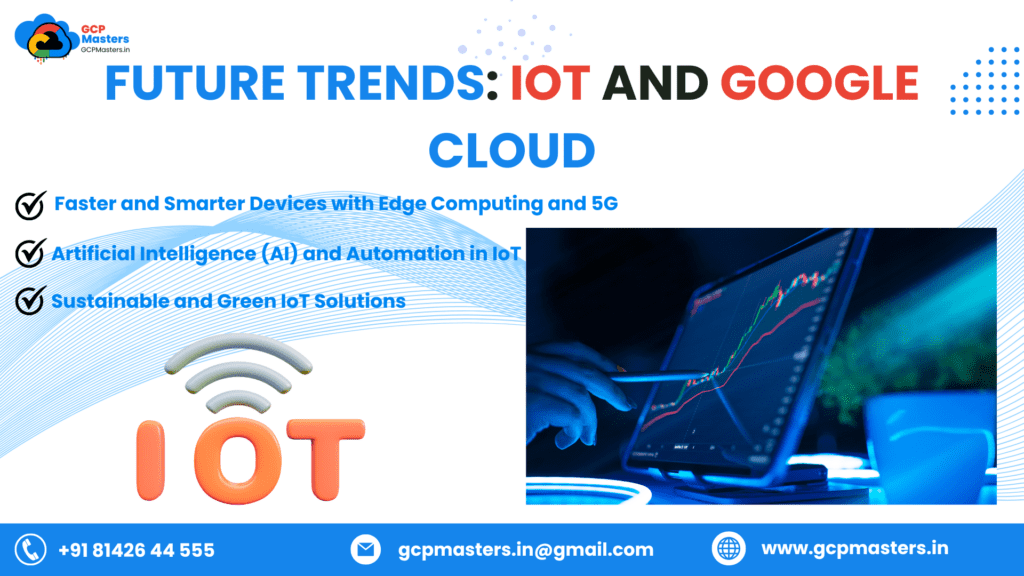
Future Trends: IoT and Google Cloud Platform for IoT
The Internet of Things (IoT) is constantly evolving, and Google Cloud is helping businesses use new technologies to make IoT more efficient, intelligent, and eco-friendly. Here are some key trends that will shape the future of IoT.
Faster and Smarter Devices with Edge Computing and 5G
Right now, most IoT devices send all their data to the cloud for processing. This can slow things down, especially for devices that need quick responses.
- Edge computing helps devices process some data on their own, reducing delays and making them work faster.
- 5G networks provide super-fast internet connections, allowing devices to send and receive data instantly.
- This is especially useful for self-driving cars, smart factories, and healthcare where quick decisions are needed.
Artificial Intelligence (AI) and Automation in IoT
IoT devices collect a lot of data, and AI helps make sense of it without human effort.
- Predictive maintenance: AI can monitor machines and warn if they need repairs before they break down.
- Smart automation: Devices can adjust settings on their own, like turning off lights when no one is in a room.
- Security improvements: AI can detect unusual activity and protect IoT systems from cyber threats.
- Better customer experiences: AI-powered IoT can personalize shopping experiences and improve customer service.
Sustainable and Green IoT Solutions
Technology is also being used to protect the environment and save resources.
- Energy-efficient systems: IoT devices can track electricity usage and help reduce energy waste.
- Smart farming: Sensors in farms help farmers use water and fertilizers wisely, reducing waste.
- Reducing pollution: Businesses can use IoT to track and lower their carbon emissions.
- Waste management: Smart recycling systems use IoT to sort and manage waste more efficiently.

Conclusion
The Internet of Things (IoT) is growing rapidly, and new technologies are making it even more powerful and useful. Google Cloud is helping businesses and industries take advantage of these advancements by providing tools that make IoT devices faster, smarter, and more efficient.
One of the biggest improvements is edge computing and 5G, which allow devices to process data more quickly and reduce delays. This is especially important for areas like self-driving cars, smart factories, and healthcare, where real-time responses are needed. Artificial intelligence (AI) and automation are also playing a huge role in IoT by helping businesses analyze large amounts of data, predict problems before they happen, and improve decision-making.
Another major focus is on sustainability and eco-friendly technology. IoT is being used to save energy, reduce waste, and protect the environment by making industries and cities more efficient. Smart systems help monitor electricity use, optimize farming, and track carbon emissions to reduce pollution.
As these technologies continue to develop, IoT will become an even bigger part of our daily lives. From connected homes and smart cities to healthcare and industries, businesses that adopt these innovations will be able to improve operations, enhance security, and create a better, more connected world. Google Cloud’s IoT solutions make it easier for companies to manage their devices, process data, and stay ahead of future trends. The future of IoT is full of possibilities, and those who embrace it will have a significant advantage in the years to come.
FAQs
Google Cloud Platform for IoT is a collection of cloud services that help businesses connect, manage, and analyze data from IoT devices securely and efficiently. It allows devices to communicate with the cloud, process real-time data, and integrate with AI and analytics tools.
Google Cloud IoT Core was retired on August 16, 2023. Businesses that relied on it had to migrate to alternative Google Cloud services like Cloud Pub/Sub for messaging, Cloud IoT Device Manager for device management, and BigQuery for data analytics.
- Cloud Pub/Sub for real-time messaging between IoT devices and applications.
- Cloud IoT Device Manager for managing device authentication and configuration.
- BigQuery for analyzing large amounts of IoT data.
- Cloud Storage for storing IoT-generated data.
- Cloud Functions for automating IoT workflows.
- Secure device authentication to prevent unauthorized access.
- Data encryption during transmission and storage.
- Access control using Identity and Access Management (IAM).
- DDoS protection to safeguard IoT networks from cyber threats.
Yes, you can still build and run IoT applications on Google Cloud using alternative services like Cloud Pub/Sub, BigQuery, and Cloud Functions for data collection, processing, and automation.
Google Cloud provides tools like Cloud Pub/Sub and Cloud Dataflow, which allow IoT devices to send real-time data to the cloud. Businesses can process this data instantly for insights, automation, and monitoring.
- Smart Cities – Traffic monitoring, air quality tracking, and smart lighting.
- Healthcare – Wearable health devices and remote patient monitoring.
- Manufacturing – Predictive maintenance and automation in factories.
- Agriculture – Smart irrigation and crop monitoring.
- Transportation – Fleet tracking and connected vehicle management.
- Set up a Google Cloud account and enable billing.
- Use Cloud Pub/Sub to set up messaging between IoT devices.
- Store IoT data using Cloud Storage or BigQuery.
- Analyze data with tools like BigQuery and Looker Studio.
- Secure your IoT environment with IAM and encryption features.
Yes, businesses can use Vertex AI and AutoML to apply machine learning to IoT data. This helps with predictive analytics, anomaly detection, and automation for smarter decision-making.
Google Cloud is known for its strong data analytics, AI, and security features, making it a great choice for IoT. However, businesses can also explore AWS IoT and Azure IoT if they need specific features that Google Cloud does not offer.
Google Cloud provides scalable solutions to handle thousands or even millions of IoT devices. Cloud Pub/Sub enables real-time messaging, while Cloud IoT Device Manager helps in registering, organizing, and monitoring devices efficiently.
Cloud Pub/Sub acts as a messaging service that allows IoT devices to send and receive data in real-time. It ensures that data flows smoothly between sensors, applications, and cloud services without delays or data loss.
Yes, Google Cloud supports API-based integrations with third-party platforms. You can connect your IoT solutions with ERP systems, monitoring tools, analytics dashboards, and AI applications to extend functionality.
Yes, Google Cloud supports edge computing, allowing IoT devices to process data closer to the source instead of relying entirely on cloud storage. This reduces latency and improves performance for real-time applications like autonomous vehicles and industrial automation.
By using BigQuery, Vertex AI, and Cloud Functions, Google Cloud helps businesses analyze IoT sensor data to predict equipment failures, schedule maintenance, and reduce downtime.
Google Cloud supports multiple programming languages, including Python, Java, Go, Node.js, and C++, making it flexible for IoT developers to build and deploy applications.
Google Cloud provides Looker Studio and Cloud Monitoring, which allow businesses to track device performance, detect anomalies, and visualize real-time IoT data in interactive dashboards.
- Smart Homes – Automating home security and energy management.
- Retail – Smart inventory tracking and customer behavior analysis.
- Energy Management – Monitoring and optimizing electricity usage in buildings.
- Connected Vehicles – Tracking vehicle health and driver behavior.
Yes, Google Cloud provides pay-as-you-go pricing and free-tier options, making it accessible for startups and small businesses to experiment with IoT solutions without high initial costs.
- Detect patterns in IoT data.
- Automate decision-making.
- Improve efficiency in manufacturing, healthcare, and smart city solutions.
